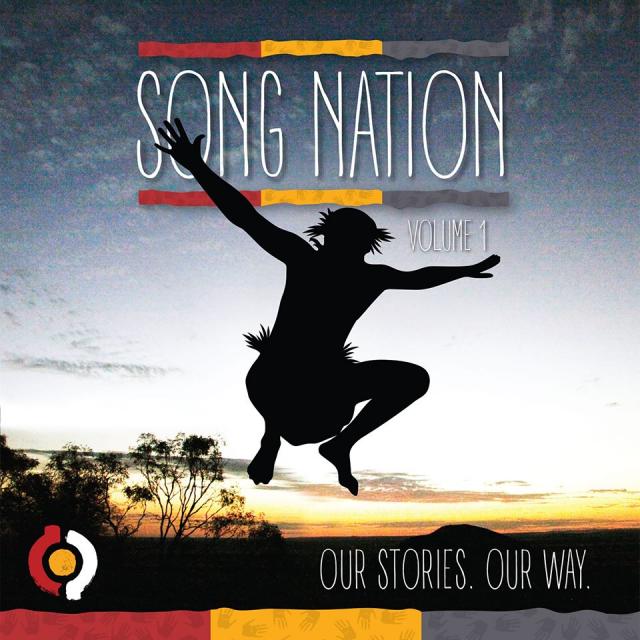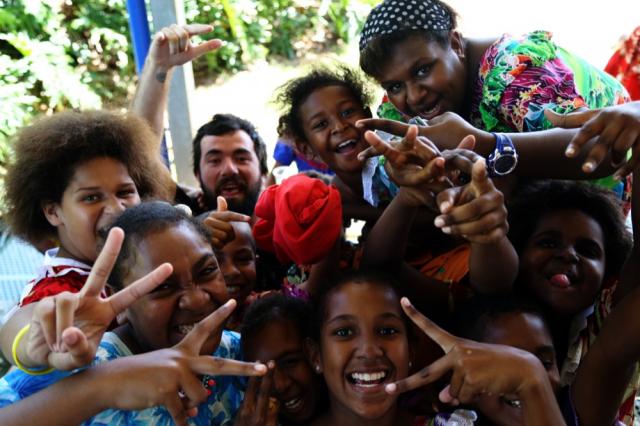
The remotest of communities in Australia can breed the most intriguing and insightful art about life in such area. Through collaborative processes, Toby Finlayson, through Desert Pea Media, has released Song Nation, a compilation of songs trying to engage catalysts for social change amongst indigenous people. Philippe Perez spoke with Toby about the project.
Tell us a bit about Desert Pea Media and it’s aims?
Desert Pea Media is a not-for-profit organisation and our objective is to create change through creative storytelling. We try to empower young people’s mantras that have hope, truth and positivity. We developed the process over a decade working in remote indigenous communities using storytelling, music making and film making as a tool to create a dialogue around cultural and social issues.
You mentioned that it took a decade to get to this point. Does it feel liberating to be able to a compilation album out after all this time?
It’s a real milestone for us; we are very excited by it. It’s been a long journey to get to this point where we are – creating material and stories that everyone is happy with. It feels really good.
It’s not always about music and performance though, isn’t it? It’s also about conveying those stories that you touch on. Could you elaborate on that and what type of stories you want to tell?
The whole point of Desert Pea Media is to use popular culture forms. Things like languages that young people speak to engage them. So essentially, the art form itself is secondary to the process of creating this dialogue. Talking about the history of communities, cultural and political contact and the understanding of those concepts. We also talk about today’s issues surrounding substance abuse, isolation, generational trauma and many similar issues.
We want to project where we want to be in our future as a community. It’s about acknowledging the past and the issues we face today but creating a positive solution to those problems.
Did you have consultations to talk about those problems prior or when you were recording the artists for Song Nation?
The whole process starts with elders and community members. Along with them come along teachers and young people. We come together; have a morning tea and talk about the history of the community. We look at what life was like for their parents and grandparents. This includes how things have changed and the history that encompasses the area we are working in.
Then, we try to look at the indication of a narrative. Looking at ‘past, present, future’, we try to achieve a story from that. The community then fills in the blanks if there is anything missing from the stories and music.
Was there a particular narrative that resonated with you?
The “Built To Last” single from the album was about paying homage to activists and Indigenous people who fought for basic human rights. Things like attendance at schools, basic health and employment, housing, plus the native title stuff.
The narrative is acknowledging the past. Those things weren’t always great for indigenous people then, and from there, we look at the situation now and where those communities are at present. We then allow the morals and cultural ideals of those periods inspire the future.
Tell me about the places that you went to in creating this compilation.
We’ve been all over Australia. Ten communities, eleven songs and eleven music videos. We reached as far as Tjuntjuntjara in Western Australia. It is one of the most remotest communities in the world. It’s north-east of Kalgoorlie within the Great Victorian Desert.
We also headed to the Torres Strait where we did two projects: one on Eddie Mabo’s traditional country, Murray Island and one project on Thursday Island too. We also then went through Queensland and New South Wales and made videos in all sorts of places.

Toby Finlayson with the Murray Island crew.
How different were the experiences making videos in all these vast and different areas?
It was incredible. It’s such an honour to be in the places that we go. It’s pretty rare to go and have the opportunity to work like that for anyone. It’s very humbling and amazing to work with these communities. Let alone in the countryside – it was spectacular travelling to far off lands.
Making eleven videos for one project is a significant task. What was the task like to compile them all together in the space of time you had?
You know, we did it over twelve years now. We’ve developed a pretty effective process in terms of doing the project. “Built To Last” however was written, recorded, and shot in three days flat, so each song really wasn’t a long-winded process. We get that stuff done quickly. It was more about the post-production that took a bit of time, as well as organising travel to these isolated areas.
Tell me about “Built To Last”. How did it come about with the Cairns community that you worked with?
We do a content workshop with a brainstorm thing like I mentioned before with young people and elders in the community. We get what they want, what they think, what their ideas are. We identified the narrative of the story, also like I mentioned before which includes finding the direction of the verses and where they fit in. We also got, for that particular song, had the chorus written with our music producer, Joel Westlake, who also does a bit of singing training too.
Him and a group of the girls were already trained choir singers, which was a bit of a surprise, worked together to get an awesome choral arrangement that gives that song a real impact.
Was there an artist or contributor that stood out and made you think: ‘this is some real untouched talent’?
There’s a young guy from Collarenebri that we’ve been working with for about four or five years now. Him, with students from the Collarenebri Central School called the Colli Crew who stood out. They’ve had a bit of triple j play. Their contribution is their eighth song they’ve composed and put together. He’s really progressed as an artist from a fifteen year old kid who hadn’t done anything with music. He now writes his own stuff at the age of eighteen and he’s really developed as a hip-hop artist. But along with that, he’s developed as a person. It’s really cool to see the development through the mentoring process.
You’ve collaborated with an organisation called the Smugglers of Light Development Foundation. Tell me more about them.
They are a partner organisation of Desert Pea Media. We have been working together on the annual Song Nation tour for about three years. They’re kind of a sister organisation, close family friends and Joel Westlake’s parents are the trustees of the foundation, so we work closely together on lots of projects. Song Nation being the flagship collaboration right now.
This is volume one of Song Nation, and I’m assuming there’ll be a volume two. What is in store for future projects for Desert Pea Media?
Well Desert Pea Media is hitting our straps now in a few ways. While we’ve been generating a lot of the rolling out for Song Nation, we’ve been out in many more communities doing more projects. We are probably three or four songs and music videos into volume two. Depending on how things progress, we’ll probably have two compilations out per year from now on.
That’s quite an output and quite a lot of travelling compared to twelve years previously?
Yeah, absolutely. It’s a wonderful challenge.
Did you envisage that you would visit so many communities and travelling so far and wide when starting this project and that there would be a volume two?
Well it’s always been a bit of a dream to have a sustainable business as well as groups of artists who are very experienced. They are all very qualified in creating this important work. I pinch myself a little bit sometimes right now as all this unfolds. It’s really cool.
Proceeds from this album are going to create further opportunities in the communities that you worked in. What type of opportunities are you planning?
All the proceeds of sales, of the licensing, and from a great deal of the lyric writing as well are all registered to Desert Pea Media. All the funding gets routed back into further Song Nation projects and to trying to get other opportunities outside of recording happening. Things like getting the outlet for young people to perform is something we want to do.
We also are keen to further develop skills in other various areas in the creative process and try to develop more mentoring facilities for the artists as well so they can get better with their music-making skills. The whole mantra of what we do is trying to create a conversation about what has gone wrong in indigenous communities. There is a massive gap between life expectancy and employment for indigenous communities in Australia. The list goes on. I’d be here forever trying to outline it all.
The purpose of this work is to get young people to create their own conversation about what they don’t like about a situation and how it may change. We try to do it in a non-confrontational way through art and through story. We then might hopefully pose solutions that can be analysed and thought about in a fun way. We can create popular culture forms that are mantras for change and for a positive future.
I think that’s pretty important in this day and age.
—-
Song Nation is out now. The compilation and more information can be found at www.desertpeamedia.com
———-
